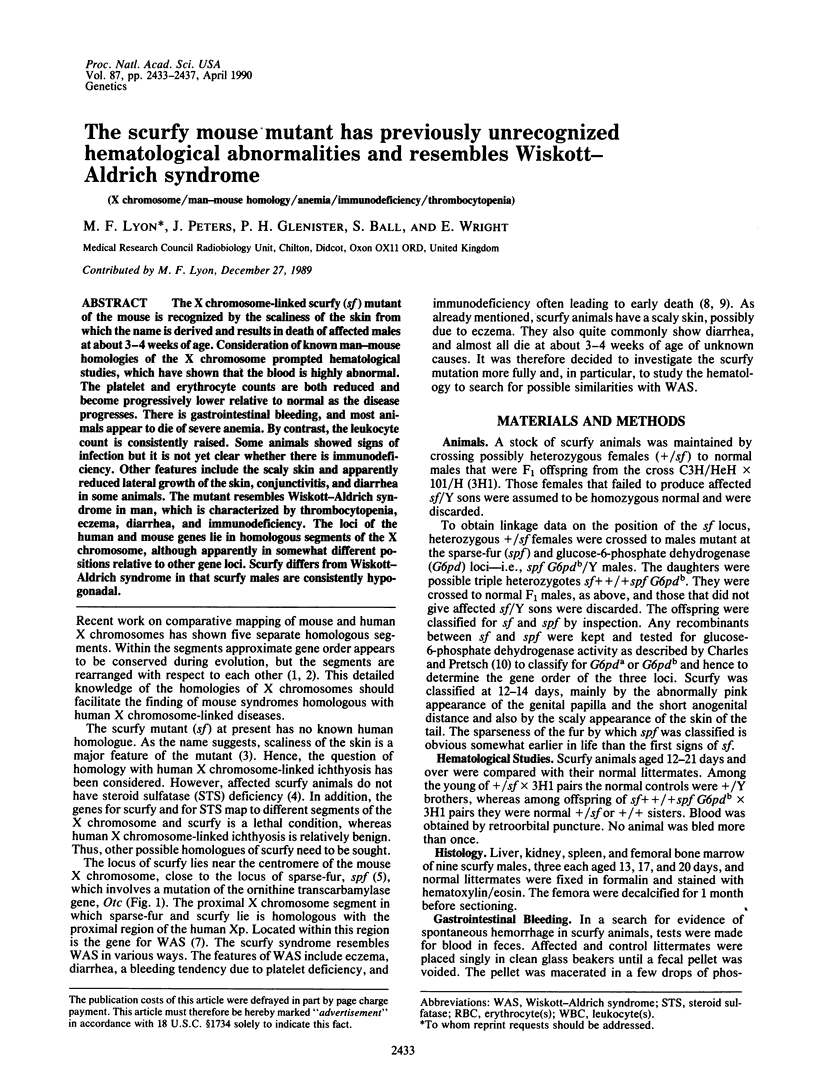The scurfy mouse mutant has previously unrecognized hematological abnormalities and resembles Wiskott-Aldrich syndrome (original) (raw)
Abstract
The X chromosome-linked scurfy (sf) mutant of the mouse is recognized by the scaliness of the skin from which the name is derived and results in death of affected males at about 3-4 weeks of age. Consideration of known man-mouse homologies of the X chromosome prompted hematological studies, which have shown that the blood is highly abnormal. The platelet and erythrocyte counts are both reduced and become progressively lower relative to normal as the disease progresses. There is gastrointestinal bleeding, and most animals appear to die of severe anemia. By contrast, the leukocyte count is consistently raised. Some animals showed signs of infection but it is not yet clear whether there is immunodeficiency. Other features include the scaly skin and apparently reduced lateral growth of the skin, conjunctivitis, and diarrhea in some animals. The mutant resembles Wiskott-Aldrich syndrome in man, which is characterized by thrombocytopenia, eczema, diarrhea, and immunodeficiency. The loci of the human and mouse genes lie in homologous segments of the X chromosome, although apparently in somewhat different positions relative to other gene loci. Scurfy differs from Wiskott-Aldrich syndrome in that scurfy males are consistently hypogonadal.

Images in this article
Selected References
These references are in PubMed. This may not be the complete list of references from this article.
- Amar L. C., Dandolo L., Hanauer A., Cook A. R., Arnaud D., Mandel J. L., Avner P. Conservation and reorganization of loci on the mammalian X chromosome: a molecular framework for the identification of homologous subchromosomal regions in man and mouse. Genomics. 1988 Apr;2(3):220–230. doi: 10.1016/0888-7543(88)90006-7. [DOI] [PubMed] [Google Scholar]
- Cattanach B. M., Isaacson J. H. Genetic control over the inactivation of autosomal genes attached to the X-chromosome. Z Vererbungsl. 1965;96(4):313–323. doi: 10.1007/BF00895048. [DOI] [PubMed] [Google Scholar]
- Charles D. J., Pretsch W. Enzyme-activity mutations detected in mice after paternal fractionated irradiation. Mutat Res. 1986 May;160(3):243–248. doi: 10.1016/0027-5107(86)90134-x. [DOI] [PubMed] [Google Scholar]
- Donnér M., Schwartz M., Carlsson K. U., Holmberg L. Hereditary X-linked thrombocytopenia maps to the same chromosomal region as the Wiskott-Aldrich syndrome. Blood. 1988 Dec;72(6):1849–1853. [PubMed] [Google Scholar]
- Lyon M. F. The William Allan memorial award address: X-chromosome inactivation and the location and expression of X-linked genes. Am J Hum Genet. 1988 Jan;42(1):8–16. [PMC free article] [PubMed] [Google Scholar]
- Mandel J. L., Willard H. F., Nussbaum R. L., Davies K. E., Romeo G. Report of the committee on the genetic constitution of the X chromosome. Cytogenet Cell Genet. 1988;49(1-3):107–128. doi: 10.1159/000132662. [DOI] [PubMed] [Google Scholar]
- Mullins L. J., Grant S. G., Stephenson D. A., Chapman V. M. Multilocus molecular mapping of the mouse X chromosome. Genomics. 1988 Oct;3(3):187–194. doi: 10.1016/0888-7543(88)90078-x. [DOI] [PubMed] [Google Scholar]
- Peacocke M., Siminovitch K. A. Linkage of the Wiskott-Aldrich syndrome with polymorphic DNA sequences from the human X chromosome. Proc Natl Acad Sci U S A. 1987 May;84(10):3430–3433. doi: 10.1073/pnas.84.10.3430. [DOI] [PMC free article] [PubMed] [Google Scholar]
- Remold-O'Donnell E., Zimmerman C., Kenney D., Rosen F. S. Expression on blood cells of sialophorin, the surface glycoprotein that is defective in Wiskott-Aldrich syndrome. Blood. 1987 Jul;70(1):104–109. [PubMed] [Google Scholar]
- Russell W. L., Russell L. B., Gower J. S. EXCEPTIONAL INHERITANCE OF A SEX-LINKED GENE IN THE MOUSE EXPLAINED ON THE BASIS THAT THE X/O SEX-CHROMOSOME CONSTITUTION IS FEMALE. Proc Natl Acad Sci U S A. 1959 Apr;45(4):554–560. doi: 10.1073/pnas.45.4.554. [DOI] [PMC free article] [PubMed] [Google Scholar]
- Searle A. G., Peters J., Lyon M. F., Hall J. G., Evans E. P., Edwards J. H., Buckle V. J. Chromosome maps of man and mouse. IV. Ann Hum Genet. 1989 May;53(Pt 2):89–140. doi: 10.1111/j.1469-1809.1989.tb01777.x. [DOI] [PubMed] [Google Scholar]
- Shelley C. S., Remold-O'Donnell E., Davis A. E., 3rd, Bruns G. A., Rosen F. S., Carroll M. C., Whitehead A. S. Molecular characterization of sialophorin (CD43), the lymphocyte surface sialoglycoprotein defective in Wiskott-Aldrich syndrome. Proc Natl Acad Sci U S A. 1989 Apr;86(8):2819–2823. doi: 10.1073/pnas.86.8.2819. [DOI] [PMC free article] [PubMed] [Google Scholar]
- Standen G. R. Wiskott-Aldrich syndrome: new perspectives in pathogenesis and management. J R Coll Physicians Lond. 1988 Apr;22(2):80–83. [PMC free article] [PubMed] [Google Scholar]